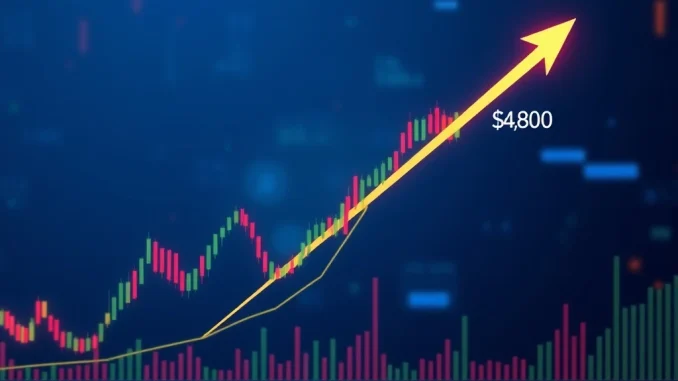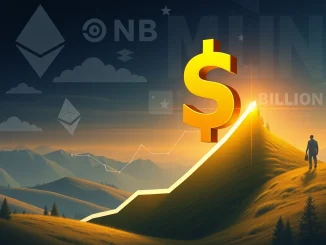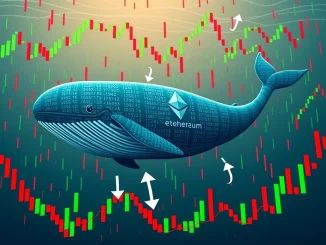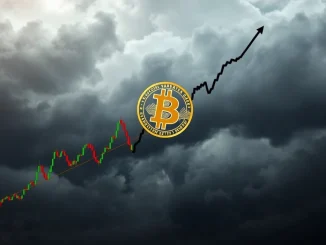
Are you keeping an eye on the latest Ethereum news? The crypto world is buzzing with renewed speculation about Ethereum’s future, particularly its potential to hit a staggering $8,000. This ambitious target for the Ethereum price is not just wishful thinking for some; it’s rooted in a fascinating theory linking ETH’s valuation to global M2 money supply growth and the transformative impact of its Proof-of-Stake transition. Let’s dive into what’s driving this optimistic outlook and what it could mean for your crypto investment.
Understanding the Ethereum Price Surge: Is $8K ETH Achievable?
The bold prediction of an $8,000 ETH price comes from crypto entrepreneur Ted Pillows, a claim that even caught the attention of Eric Trump. Pillows’ core argument is straightforward yet profound: Ethereum, as a decentralized asset, is uniquely positioned to absorb the excess liquidity flooding global markets due to central bank policies. He suggests that as the total amount of money in circulation (M2 money supply) expands, assets like Ethereum, often seen as a hedge against inflation, will naturally capture a larger share of investor portfolios. This macroeconomic shift, he believes, makes Ethereum significantly undervalued at current levels, setting the stage for substantial price appreciation.
The narrative hinges on Ethereum’s distinctive role within the blockchain ecosystem. Beyond being a digital currency, Ethereum powers a vast network of decentralized applications (dApps), decentralized finance (DeFi) protocols, and non-fungible tokens (NFTs). Its fundamental strength is underscored by:
- High Total Value Locked (TVL): Billions are locked in DeFi protocols built on Ethereum, signaling robust utility.
- Active Developer Engagement: A vibrant community continually innovates and builds on the platform.
- Growing Staked ETH: Increasing amounts of ETH are being staked, reducing circulating supply and securing the network.
The Power of Proof-of-Stake: How Ethereum’s Upgrade Fuels Growth
A pivotal factor in Ethereum’s appeal and its potential for significant price appreciation is its transition to a Proof-of-Stake (PoS) consensus model in 2022. This shift, often referred to as ‘The Merge,’ brought several critical improvements:
- Reduced Energy Consumption: Drastically lowered its environmental footprint, making it more sustainable.
- Deflationary Mechanism: Through EIP-1559, a portion of transaction fees is burned, making ETH a potentially deflationary asset over time.
- Enhanced Security: Staking ETH strengthens network security and decentralization.
These enhancements not only make Ethereum more attractive to environmentally conscious investors but also create a supply-side squeeze, which, combined with growing demand, could propel the Ethereum price upwards. The move to Proof-of-Stake has fundamentally altered Ethereum’s economic model, making it a more compelling asset for long-term holders.
Global M2 Growth and Its Impact on Ethereum’s Valuation
The correlation between global M2 growth and asset valuations is a key pillar of the $8,000 ETH projection. M2 money supply is a broad measure of the amount of money in circulation, including cash, checking deposits, and easily convertible near money. When central banks implement expansionary monetary policies, such as quantitative easing, the M2 supply increases, leading to more liquidity in the financial system. Historically, this excess liquidity often flows into various asset classes, including stocks, real estate, and now, increasingly, cryptocurrencies.
Proponents of this theory argue that Ethereum, with its decentralized nature and limited supply (especially with the burning mechanism), acts as a digital store of value that can absorb this expanding liquidity. As traditional financial assets face inflationary pressures, investors may increasingly turn to assets like ETH as a hedge. This flow of capital, driven by macro-economic factors like M2 growth, could significantly re-rate Ethereum’s valuation, making the $8,000 target seem less outlandish.
Navigating Risks and Competition in Crypto Investment
While the potential for an $8,000 Ethereum price is exciting, it’s crucial to acknowledge the challenges and risks that lie ahead for any crypto investment. The path to such a valuation is rarely linear and involves navigating several hurdles:
- Regulatory Uncertainties: Governments worldwide are still grappling with how to regulate crypto assets. Shifting policies could impact market sentiment and adoption.
- Competition: Ethereum faces fierce competition from emerging blockchains like Solana and Avalanche, which often boast faster transactions or lower fees. While Ethereum’s Layer 2 solutions are mitigating scalability concerns, high gas fees during peak usage can still deter new users.
- Macroeconomic Headwinds: Factors such as interest rate hikes, global recessions, or geopolitical instability could dampen investor appetite for volatile assets like ETH.
- Technological Risks: While robust, any major bug or security exploit could significantly impact confidence and price.
Analysts consistently emphasize that the $8,000 projection remains speculative. It’s a forecast based on a specific economic correlation rather than a guaranteed outcome. However, potential institutional adoption, including the approval of spot Ethereum ETFs, could provide a massive boost to long-term demand and validate Ethereum’s position as a mainstream investment asset. For investors, strategies like dollar-cost averaging and diversification remain essential to navigate the inherent volatility of the crypto market and manage risk effectively.
Ethereum’s journey is a testament to its dual identity: a cutting-edge technological platform and a dynamic financial asset. Its ability to absorb global liquidity while maintaining a deflationary supply model positions it as a compelling candidate for substantial growth. Yet, the market’s reliance on speculative sentiment means that the ultimate outcome will depend on a complex interplay of ongoing technological innovation, evolving regulatory landscapes, and broader macroeconomic conditions. As the crypto space continues to mature, Ethereum’s role will undoubtedly remain at the forefront of this digital revolution, making it a critical asset to watch for anyone interested in the future of finance and technology.
Frequently Asked Questions (FAQs)
Q1: What is the significance of M2 money supply growth for Ethereum’s price?
A1: M2 money supply growth refers to the increase in the total amount of money in circulation. When central banks expand the money supply, it can lead to excess liquidity in the financial system. Proponents argue that decentralized assets like Ethereum can absorb this liquidity, acting as a hedge against inflation and driving their prices higher as investors seek alternative stores of value.
Q2: How does Ethereum’s Proof-of-Stake (PoS) transition impact its value?
A2: The transition to Proof-of-Stake (PoS) in 2022 significantly reduced Ethereum’s energy consumption, making it more sustainable. More importantly, it introduced a deflationary mechanism (EIP-1559), where a portion of transaction fees is burned. This reduction in supply, combined with growing demand and increased network security from staking, can contribute to a higher ETH price over time.
Q3: Is the $8,000 Ethereum price prediction a certainty?
A3: No, the $8,000 Ethereum price prediction is highly speculative. It is a forecast based on specific macroeconomic correlations (like M2 growth) and fundamental improvements (like PoS). While it highlights potential, it is not a guaranteed outcome and is subject to market volatility, regulatory changes, competition, and broader economic conditions.
Q4: What are the main risks associated with investing in Ethereum?
A4: Key risks include regulatory uncertainties (governments are still developing crypto frameworks), competition from other blockchains (e.g., Solana, Avalanche), high gas fees during peak usage, and broader macroeconomic factors like interest rate hikes or recessions that can reduce risk appetite for volatile assets. Investors should always conduct thorough research and consider diversification.
Q5: What investment strategies are recommended for volatile assets like ETH?
A5: For volatile assets like Ethereum, strategies such as dollar-cost averaging (investing a fixed amount regularly, regardless of price) and diversification (spreading investments across different assets) are often recommended. These approaches can help mitigate the impact of short-term price fluctuations and build a more resilient portfolio.



